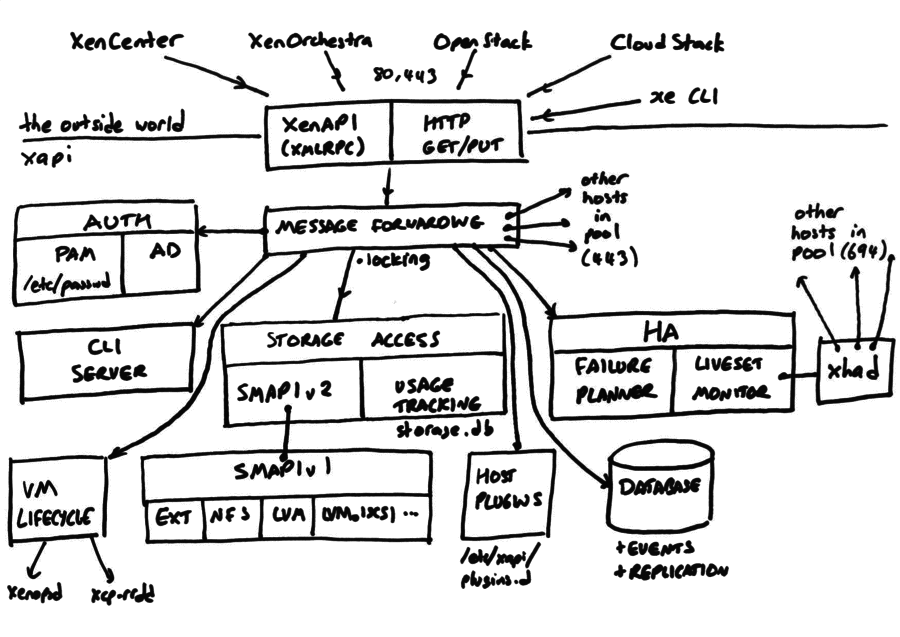Xapi is responsible for
Note that Xapi delegates core functions such as
The following diagram shows the internals of Xapi:

The top of the diagram shows the XenAPI clients: XenCenter, XenOrchestra, OpenStack and CloudStack using XenAPI and HTTP GET/PUT over ports 80 and 443 to talk to xapi. These XenAPI (XMLRPC over HTTP POST) and HTTP GET/PUT are always authenticated using either PAM (by default using the local passwd and group files) or through Active Directory.
The APIs are classified into categories:
If the incoming API call should be resent to the master than a XenAPI HOST_IS_SLAVE
error message containing the master’s IP is sent to the client.
Once past the initial checks, API calls enter the “message forwarding” layer which
current_operations mechanism)If the request should run locally then a direct function call is used; otherwise the message forwarding code makes a synchronous API call to a specific other host. Note: Xapi currently employs a “thread per request” model which causes one full POSIX thread to be created for every request. Even when a request is forwarded the full thread persists, blocking for the result to become available.
If the XenAPI call is a VM lifecycle operation then it is converted into a Xenopsd API call and forwarded over a Unix domain socket. Xapi and Xenopsd have similar notions of cancellable asynchronous “tasks”, so the current Xapi task (all operations run in the context of a task) is bound to the Xenopsd task, so cancellation is passed through and progress updates are received.
If the XenAPI call is a storage operation then the “storage access” layer
VDI.attach
call) to persistent storageInternally the SMAPIv1 plugins use privileged access to the Xapi database to directly set fields (e.g. VDI.virtual_size) that would be considered read/only to other clients. The SMAPIv1 plugins also rely on Xapi for
The Xapi database contains Host and VM metadata and is shared pool-wide. The master
keeps a copy in memory, and all other nodes remote queries to the master. The database
associates each object with a generation count which is used to implement the XenAPI
event.next and event.from APIs. The database is routinely asynchronously flushed to disk
in XML format. If the “redo-log” is enabled then all database writes are made synchronously
as deltas to a shared block device. Without the redo-log, recent updates may be lost
if Xapi is killed before a flush.
High-Availability refers to planning for host failure, monitoring host liveness and then
following-through on the plans. Xapi defers to an external host liveness monitor
called xhad. When xhad confirms that a host has failed – and has been
isolated from the storage – then Xapi will restart any VMs which have failed and which
have been marked as “protected” by HA. Xapi can also impose admission control to prevent
the pool becoming too overloaded to cope with n arbitrary host failures.
The xe CLI is implemented in terms of the XenAPI, but for efficiency the implementation
is linked directly into Xapi. The xe program remotes its command-line to Xapi,
and Xapi sends back a series of simple commands (prompt for input; print line; fetch file;
exit etc).